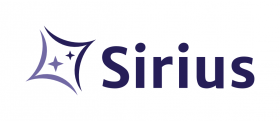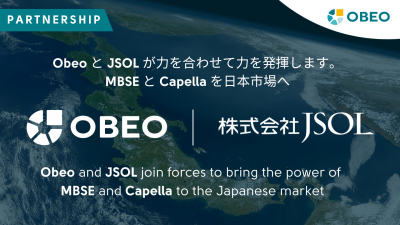Grande annonce : Partenariat passionnant entre Obeo et JSOL Corporation
Nous sommes ravis d’annoncer un partenariat révolutionnaire entre Obeo et JSOL Corporation, une société du groupe NTT DATA et le Japan Research Institute.
Ce partenariat marque un moment charnière alors qu’Obeo et JSOL Corporation unissent leurs forces pour apporter la puissance de #MBSE et de #Capella sur le marché japonais. La compétence et les solutions d’Obeo dans MBSE, combinées à la compréhension profonde du paysage industriel japonais de JSOL, créent une synergie inégalée. Ensemble, nous nous engageons à stimuler l’innovation, l’efficacité et l’excellence dans l’ingénierie des systèmes et les pratiques MBSE.
Nous invitons tous nos précieux partenaires, clients et amis de la communauté Capella à nous rejoindre dans ce voyage passionnant. Restez à l’affût des mises à jour, des idées et des histoires de réussite, car nous nous engageons à travailler main dans la main avec JSOL pour fournir à tous les p...
Actualites
 Regardez le replay du webinaire Capella du 14 Septembre 2023 (en anglais)
Digitally Assisted Design for Safety
Votre système est-il robuste à la perte d’une ou plusieurs fonctions ? Votre système nécessite-t-il une interaction avec d’autres systèmes pour fonctionner en toute sécurité ?La conception et le concept opérationnel du système comprennent-ils des moyens d’urgence ? Ces moyens d’urgence atténuent-ils correctement les risques ?
Ces considérations et d’autres similaires deviennent de plus en plus importantes avec l’émergence de systèmes autonomes et de systèmes complexes. L’introduction d’outils numériques et en particulier l’ingénierie des systèmes basés sur des modèles permet de saisir la complexité de ces produits à partir de l’analyse opérationnelle et de soutenir le processus tout au long du cycle de vie du produit.
Avec ATICA, les architectes et les concepteurs de systèmes seront en mesure d’analyser les répercussions sur la sécurité à partir des besoins...
Regardez le replay du webinaire Capella du 14 Septembre 2023 (en anglais)
Digitally Assisted Design for Safety
Votre système est-il robuste à la perte d’une ou plusieurs fonctions ? Votre système nécessite-t-il une interaction avec d’autres systèmes pour fonctionner en toute sécurité ?La conception et le concept opérationnel du système comprennent-ils des moyens d’urgence ? Ces moyens d’urgence atténuent-ils correctement les risques ?
Ces considérations et d’autres similaires deviennent de plus en plus importantes avec l’émergence de systèmes autonomes et de systèmes complexes. L’introduction d’outils numériques et en particulier l’ingénierie des systèmes basés sur des modèles permet de saisir la complexité de ces produits à partir de l’analyse opérationnelle et de soutenir le processus tout au long du cycle de vie du produit.
Avec ATICA, les architectes et les concepteurs de systèmes seront en mesure d’analyser les répercussions sur la sécurité à partir des besoins...
 Participe do webinar em 11 de julho de 2023
Assista ao replay
PdQSat: Aplicação MBSE em um projeto universitário
Neste webinar, Bruna Queiroz e Maria Letícia Fraga compartilharão sua experiência no uso do Capella para o desenvolvimento e propostas da arquitetura do PdQSat, um CubeSat desenvolvido pela Escola de Engenharia da UFMG e pelo Instituto de Ciências Exatas da UFMG.O PdQSat é um projeto multidisciplinar com duas missões, uma de cunho tecnológico para caracterização de uma bateria de Li-S e um micro-supercapacitor, e outra missão voltada para o desenvolvimento educacional de estudantes e professores de diversas áreas da engenharia. Nesse contexto, MBSE foi utilizado para apoiar a análise do sistema e seu contexto, melhorar a comunicação entre os interessados e aumentar a qualidade do sistema final.Junte-se a este webinar para descobrir como o MBSE e o Capella ajudaram a equipe a capturar e analisar o contexto operacional e as funções do sistema, além de projet...
Participe do webinar em 11 de julho de 2023
Assista ao replay
PdQSat: Aplicação MBSE em um projeto universitário
Neste webinar, Bruna Queiroz e Maria Letícia Fraga compartilharão sua experiência no uso do Capella para o desenvolvimento e propostas da arquitetura do PdQSat, um CubeSat desenvolvido pela Escola de Engenharia da UFMG e pelo Instituto de Ciências Exatas da UFMG.O PdQSat é um projeto multidisciplinar com duas missões, uma de cunho tecnológico para caracterização de uma bateria de Li-S e um micro-supercapacitor, e outra missão voltada para o desenvolvimento educacional de estudantes e professores de diversas áreas da engenharia. Nesse contexto, MBSE foi utilizado para apoiar a análise do sistema e seu contexto, melhorar a comunicação entre os interessados e aumentar a qualidade do sistema final.Junte-se a este webinar para descobrir como o MBSE e o Capella ajudaram a equipe a capturar e analisar o contexto operacional e as funções do sistema, além de projet...
 Regardez le replay du webinar (Jeudi 29 juin 2023)(en anglais)
Sirius Web est un projet open-source qui simplifie le développement d’applications de modélisation graphique web. Il permet aux utilisateurs de créer, modifier et visualiser leurs propres données dans des vues personnalisées.
Sirius Web prend en charge les vues nodales, textuelles et basées sur des formulaires, ce qui le rend adapté à diverses applications telles que la modélisation d’architecture logicielle, l’ingénierie de systèmes basés sur des modèles, l’analyse de sûreté, la gestion de bases de données, et plus encore...
Joignez-vous à nous pour une visite guidée du projet Sirius Web :- Quels sont les principes fondamentaux de Sirius Web?- À quoi ressemble une application créée avec Sirius Web pour les utilisateurs finaux?- Où pouvez-vous intégrer vos applications Web Sirius à d’autres applications Web?
Mélanie BATS - CTO at Obeo
Mélanie Bats travaille comme CTO chez Obeo. Dans m...
Regardez le replay du webinar (Jeudi 29 juin 2023)(en anglais)
Sirius Web est un projet open-source qui simplifie le développement d’applications de modélisation graphique web. Il permet aux utilisateurs de créer, modifier et visualiser leurs propres données dans des vues personnalisées.
Sirius Web prend en charge les vues nodales, textuelles et basées sur des formulaires, ce qui le rend adapté à diverses applications telles que la modélisation d’architecture logicielle, l’ingénierie de systèmes basés sur des modèles, l’analyse de sûreté, la gestion de bases de données, et plus encore...
Joignez-vous à nous pour une visite guidée du projet Sirius Web :- Quels sont les principes fondamentaux de Sirius Web?- À quoi ressemble une application créée avec Sirius Web pour les utilisateurs finaux?- Où pouvez-vous intégrer vos applications Web Sirius à d’autres applications Web?
Mélanie BATS - CTO at Obeo
Mélanie Bats travaille comme CTO chez Obeo. Dans m...
 (Re)Découvrez le webinaire du 11 juillet 2023 en replay sur notre chaîne Youtube(en anglais)
Connecting Capella and ModelCenter to Analyze System Architecture
Rejoignez-nous pour un webinaire instructif sur l’intégration de Capella avec l’analyse technique utilisant ModelCenter.Ce webinaire présentera l’utilisation de Capella pour créer le modèle d’architecture des systèmes et l’utilisation de ModelCenter pour connecter Capella à tout outil d’analyse technique pour la vérification des exigences et l’optimisation des systèmes tout au long du cycle de vie du produit. Le webinaire offrira également un forum pour fournir et recueillir des commentaires sur les caractéristiques du connecteur Capella et des idées sur les initiatives de feuille de route. Il s’agira d’un webinaire intéressant qui favorisera la collaboration.Au cours de cette session, nos présentateurs experts démontreront l’intégration transparente entre Capella et ModelCenter, permettant la promesse de MBSE. Ils illustrero...
(Re)Découvrez le webinaire du 11 juillet 2023 en replay sur notre chaîne Youtube(en anglais)
Connecting Capella and ModelCenter to Analyze System Architecture
Rejoignez-nous pour un webinaire instructif sur l’intégration de Capella avec l’analyse technique utilisant ModelCenter.Ce webinaire présentera l’utilisation de Capella pour créer le modèle d’architecture des systèmes et l’utilisation de ModelCenter pour connecter Capella à tout outil d’analyse technique pour la vérification des exigences et l’optimisation des systèmes tout au long du cycle de vie du produit. Le webinaire offrira également un forum pour fournir et recueillir des commentaires sur les caractéristiques du connecteur Capella et des idées sur les initiatives de feuille de route. Il s’agira d’un webinaire intéressant qui favorisera la collaboration.Au cours de cette session, nos présentateurs experts démontreront l’intégration transparente entre Capella et ModelCenter, permettant la promesse de MBSE. Ils illustrero...



